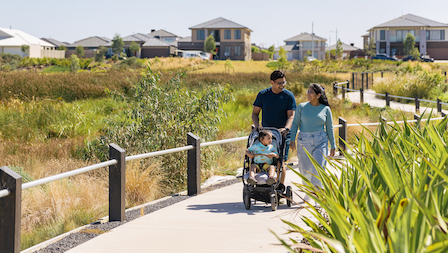How much do you need for a house deposit in Australia?

Dreaming of having your own place? Working out the finances to determine your path to homeownership can initially feel a little overwhelming, but it doesn’t have to be. Whether you're new to the idea of home buying in Australia or you're moving to a different area, understanding the role of a deposit is your first step to unlocking your new front door.
In this blog, you’ll dive deep into what a house deposit is, key elements influencing your deposit amount, and even explore some low-deposit home loan options.
Important reminder: This content is for informational purposes only and does not constitute financial advice. Please conduct your own research and consult with qualified financial advisors before making any financial decisions*.
What a house deposit is and why it matters
Embarking on the journey to homeownership in Australia often begins with a single, crucial question: how much do you need for a house deposit? This first financial step is beyond just a sum of money. It is a clear demonstration of your willingness to invest. You can think of your deposit as the foundation of your home loan. This tells the lender how much money you will borrow, and the repayment terms are outlined for you into the future. Lenders will scrutinise the size of your deposit as a major signpost with regard to your financial discipline and ability, and therefore, this is a keystone to your potential to receive a home loan.
While owning your ideal property might feel expansive, navigating the financial landscape requires clear insight into how much you'll need and the pathways available to help you get there. In this guide, we'll walk you through the essentials of house deposits, from typical amounts and influencing factors to valuable saving strategies and available support options, helping you prepare for a confident step into the Australian property market.
Typical deposit amounts for a property in Australia

A general rule of thumb for buying homes is that your deposit should be around 20% of the property's value. This 20% figure is often considered ideal because it may help you avoid extra costs like Lender's Mortgage Insurance (LMI). This raises a common question: how much do you need for a house deposit to bypass LMI? But don't worry if reaching that 20% seems challenging. Your dream home doesn't necessarily depend on it, as plenty of pathways are designed to help you bridge the deposit gap. To help you better understand what these deposit amounts might look like, here are some examples:
| Property Value | 20% Deposit (no LMI) | 5% Deposit (with LMI) |
|---|---|---|
| $700,000 | $140,000 | $35,000 plus LMI |
| $580,000 | $116,000 | $29,000 plus LMI |
| $350,000 | $70,000 | $17,500 plus LMI |
Factors influencing your minimum deposit

First, it’s crucial to grasp that the amount of house deposit you will need is not going to be the same across the board. Other pressing factors, such as the home's location and price range, have a greater influence.
Property values vary significantly in suburbs and regions throughout Australia. Your borrowing potential - meaning how much a lender is willing to lend you - is equally important. Lenders have very distinct, agreed-upon policies that take into account your income, expenses, and debts, as well as your savings history, credit file, and whether you have an ongoing employment income.
Options for low-deposit home loans
Many aspiring home purchasers often find it hard to save a 20% deposit. Here’s the good news: there is several pathways to assist you in achieving your dream home. Below are some options that you can look into:
1. Low deposit loans
A low deposit loan like the First Home Guarantee scheme (e.g. a 5% minimum deposit) allows first home buyers to buy and own a home with a smaller cash outlay up front. It’s important to take note that these loans typically incur Lender's Mortgage Insurance (LMI), which will protect your lender should you default on your repayments, in which case the cost will likely be passed onto you.
2. Family guarantee
A family member can offer equity in their property as security for a portion of your loan, which may allow you to borrow more than you would have without the need for a larger cash deposit.
3. Shared equity schemes
A shared equity scheme is where a government body or another person/party offers part of the purchase price in return for a share of the equity in the property. An example of this is the Help to Buy scheme, an Australian government shared equity scheme to help eligible buyers buy their home, both new and existing.
4. Government schemes
Tap into the valuable assistance offered through various state and/or federal government schemes designed to assist first-home buyers. These schemes usually involve a reduced deposit and/or monetary benefit. For instance, the First Home Super Saver Scheme allows first home buyers to potentially save faster due to a lower tax rate in a super environment and use a portion of your superannuation savings towards your deposit.
Knowing how much deposit you need for a house can also influence which of these options are best for you.
What to consider before committing to a deposit amount

When deciding on your deposit, it's essential to think beyond just that initial amount. It is in your best interests to weigh your deposit size against other upfront expenses associated with purchasing property. These costs can include stamp duty, legal fees, and building inspections. Keep in mind that a smaller deposit typically results in higher loan repayments and increased interest throughout the loan because you'll be borrowing more money at the start. Conversely, a larger deposit may help you save on overall interest and reduce your monthly payments.
Always plan to have a financial buffer to cover any unexpected expenses that might pop up, ensuring your peace of mind and security in your new home. Careful planning will determine how much you actually need for a suitable house deposit.
Tips to save for your house deposit more effectively
Saving for a home can feel like a significant challenge, but the right strategies can get you to your deposit faster. Here’s how to make your savings journey more effective:
1. Understand your finances
It's key to gain clarity on where your money truly goes. Start by tracking your spending, perhaps using budgeting apps that can highlight areas where you can genuinely save more. Understanding your financial habits empowers you to set realistic goals and stay on track.
2. Put your savings on autopilot
Make saving effortless by setting up a dedicated 'house deposit' account, ideally one that offers a good interest rate. Set up a direct debit to automatically transfer funds into this account. This consistency allows your contributions to grow steadily, building your deposit without constant manual effort.
3. Reduce or repay debts
Debts often come with interest payments that can consume money better directed to your deposit. By actively reducing or paying off existing debts like car finance or personal loans, you free up significant funds. Also, consider exploring debt consolidation options, which might help reduce fees and overall interest paid.
4. Make your expenses work for you
Familiarise yourself with credit cards or applications that offer cashback or reward points on your everyday purchases. While these returns won't replace your core savings efforts, they can certainly provide a welcome, incremental boost to your deposit fund over time, with little extra effort.
Start your deposit planning today

Planning your deposit the right way is crucial for becoming a homeowner. You can use home loan repayment and borrowing power calculators to estimate your minimum deposit amount, based on your preferred property value and your current situation. It's also a good idea to speak with a lender or a mortgage broker early on, as they can provide tailored recommendations based on your borrowing capacity, genuine savings requirements, and available loan options. Don’t overlook your research either - government grant websites and criteria based on your state or territory can help you find suitable support programs.
Ready to take your next step? Find your potential new home with Frasers Property today.
While many people will consider 20% a significant deposit to avoid Lender's Mortgage Insurance (LMI), you could secure a home loan with a deposit less than 5% as long as there is a government scheme or LMI in place. The minimum amount is wholly dependent on your situation and lender.
There is no set time frame given your income, expenses, and personal savings rate. National averages may suggest it can take many years to save for a deposit that represents 20% of the median house price; however, if you have a savings plan and take advantage of different support programs, it may take much less.
A lender may look for "genuine savings", which is often considered consistent money saved/accumulated over some time (at least three months). Genuine savings will support your case as it shows discipline in your savings history. That said, some lenders may accept non-genuine savings (gifts, inheritances) as long as the funds have been in your account for a period of time.
This depends on the lender, as each one has its own distinct policies. However, most lenders will want to see 5% of the deposit as "genuine savings". Gifts and inheritances can be considered but remember to check with your lender before proceeding.
Having a bigger deposit may reduce your monthly repayments, reduce the total interest paid over the loan's life, and help avoid LMI. That said, waiting longer to save more could also mean an increase in the price of the property, costing you any benefits of having a bigger deposit. It is a mixture of making your money work for you against getting into the market quicker, and only you and your market conditions will know where to go with this.
*First Home Guarantee Scheme (FHBG), other government schemes and links to external websites set out in this article are provided as a general guide only and do not constitute advice. Actual figures, eligibility and grants may vary depending on the customer’s individual circumstances and the eligibility criteria outlined on different state and territory government websites. Purchasers are responsible for seeking independent professional advice or making their own enquiries. No representations or warranties are made as to the accuracy, currency or completeness of any estimates and its contents.
See more articles on
















